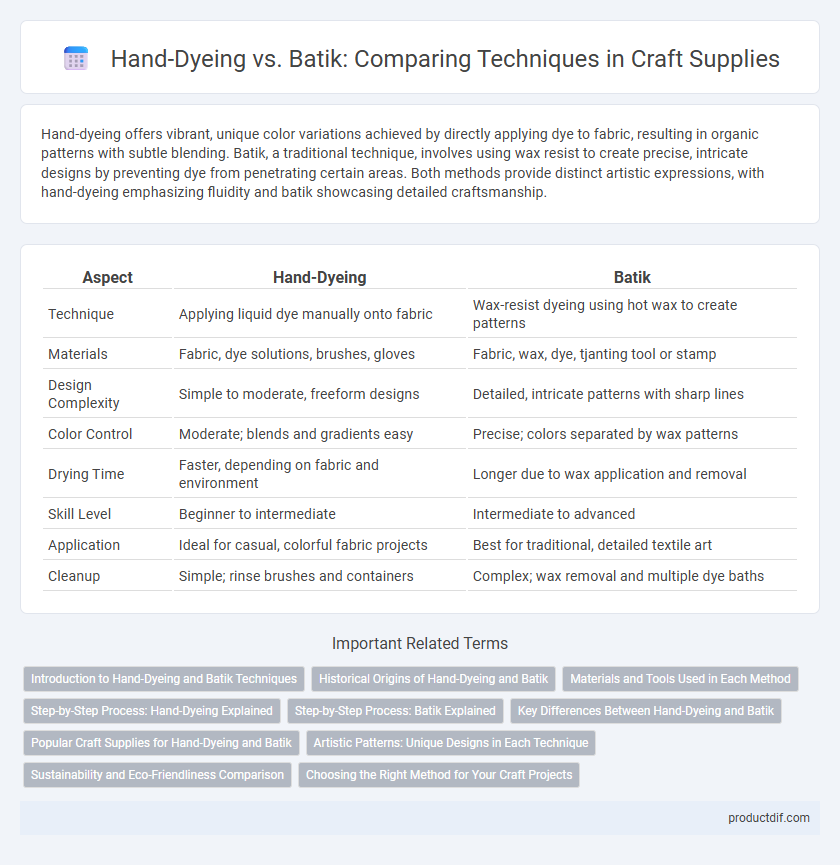Hand-dyeing offers vibrant, unique color variations achieved by directly applying dye to fabric, resulting in organic patterns with subtle blending. Batik, a traditional technique, involves using wax resist to create precise, intricate designs by preventing dye from penetrating certain areas. Both methods provide distinct artistic expressions, with hand-dyeing emphasizing fluidity and batik showcasing detailed craftsmanship.
Table of Comparison
| Aspect | Hand-Dyeing | Batik |
|---|---|---|
| Technique | Applying liquid dye manually onto fabric | Wax-resist dyeing using hot wax to create patterns |
| Materials | Fabric, dye solutions, brushes, gloves | Fabric, wax, dye, tjanting tool or stamp |
| Design Complexity | Simple to moderate, freeform designs | Detailed, intricate patterns with sharp lines |
| Color Control | Moderate; blends and gradients easy | Precise; colors separated by wax patterns |
| Drying Time | Faster, depending on fabric and environment | Longer due to wax application and removal |
| Skill Level | Beginner to intermediate | Intermediate to advanced |
| Application | Ideal for casual, colorful fabric projects | Best for traditional, detailed textile art |
| Cleanup | Simple; rinse brushes and containers | Complex; wax removal and multiple dye baths |
Introduction to Hand-Dyeing and Batik Techniques
Hand-dyeing involves manually applying dye to fabric using brushes, sponges, or direct immersion to create unique, vibrant patterns with varied color intensity. Batik is a wax-resist dyeing technique where hot wax is applied to fabric sections to block dye penetration, forming intricate designs through multiple dyeing and waxing stages. Both methods are popular in craft supply markets for producing personalized textiles with distinct aesthetic qualities.
Historical Origins of Hand-Dyeing and Batik
Hand-dyeing traces its roots to ancient civilizations such as Egypt and India, where natural dyes extracted from plants, minerals, and insects were used to color textiles. Batik, originating from Indonesia, specifically Java, evolved as a wax-resist dyeing technique with a rich cultural heritage dating back over a thousand years. Both methods reflect distinctive historical craftsmanship and regional artistry, influencing modern fabric dyeing and textile design worldwide.
Materials and Tools Used in Each Method
Hand-dyeing typically involves using fabric dyes, brushes, sponges, and gloves, allowing direct application of color onto textiles for vibrant, customizable results. Batik relies on wax-resist techniques, utilizing tools like canting pens or brushes to apply hot wax, along with natural or synthetic dyes that penetrate only unwaxed areas. The essential tools for batik include a wax pot, tjanting, and dye baths, contrasting with the more straightforward equipment required for hand-dyeing processes.
Step-by-Step Process: Hand-Dyeing Explained
Hand-dyeing involves immersing fabric in dye baths where colors penetrate unevenly, creating unique variations with each piece. The process starts with fabric preparation, including washing and mordant application to fix dyes, followed by controlled soaking in chosen dye colors for specific time intervals. After dyeing, the fabric is rinsed, dried, and sometimes heat-set to ensure colorfastness, offering crafters vibrant, one-of-a-kind textile creations.
Step-by-Step Process: Batik Explained
Batik involves applying wax to fabric in detailed patterns before dyeing, allowing the wax to resist color and create intricate designs through a process of waxing, dyeing, and wax removal. Hand-dyeing uses immersion techniques where fabric is dipped into dye baths, producing more uniform color but fewer complex patterns. The batik process requires careful layering of wax and dye steps to achieve its signature multi-colored effects and detailed motifs.
Key Differences Between Hand-Dyeing and Batik
Hand-dyeing involves applying dye directly to fabric with brushes, sponges, or dipping methods, allowing for spontaneous and varied color patterns. Batik uses wax-resist techniques to create intricate designs by applying hot wax before dyeing, which prevents dye penetration in certain areas, resulting in detailed motifs. The key difference lies in hand-dyeing's freeform color application versus Batik's controlled, patterned approach using wax resist.
Popular Craft Supplies for Hand-Dyeing and Batik
Popular craft supplies for hand-dyeing include fiber-reactive dyes, natural fabrics like cotton and silk, rubber gloves, and squeeze bottles for precise application. Batik enthusiasts often use beeswax, tjanting tools for wax application, canting pens, and natural or synthetic dyes to create intricate patterns on fabric. Both methods benefit from mordants and fixatives to enhance colorfastness and durability in finished textile pieces.
Artistic Patterns: Unique Designs in Each Technique
Hand-dyeing produces vibrant, individualistic artistic patterns through the application of color directly onto fabric, allowing for fluid gradients and spontaneous designs. Batik uses wax-resist techniques to create intricate, repeatable motifs with sharp contrasts and detailed line work, emphasizing precision and tradition. Each method results in unique textile art, where hand-dyeing offers organic, one-of-a-kind patterns and batik provides culturally rich, meticulously crafted designs.
Sustainability and Eco-Friendliness Comparison
Hand-dyeing techniques often use natural, biodegradable dyes derived from plants, promoting sustainability by reducing chemical runoff and waste. Batik processes typically involve wax-resist methods that can require synthetic dyes and energy-intensive heating, which may impact eco-friendliness negatively. Choosing hand-dyeing with organic materials supports lower environmental footprints and aligns with green crafting practices in the textile industry.
Choosing the Right Method for Your Craft Projects
Hand-dyeing offers vibrant, customizable colors ideal for small-scale craft projects requiring precise control over shading, while batik produces intricate patterns using wax-resist techniques perfect for fabric art with detailed designs. Selecting between hand-dyeing and batik hinges on the desired texture, pattern complexity, and project scale. Craft enthusiasts prioritize color intensity and design intricacy to determine the most suitable method for their creative goals.
Hand-dyeing vs Batik Infographic

 productdif.com
productdif.com